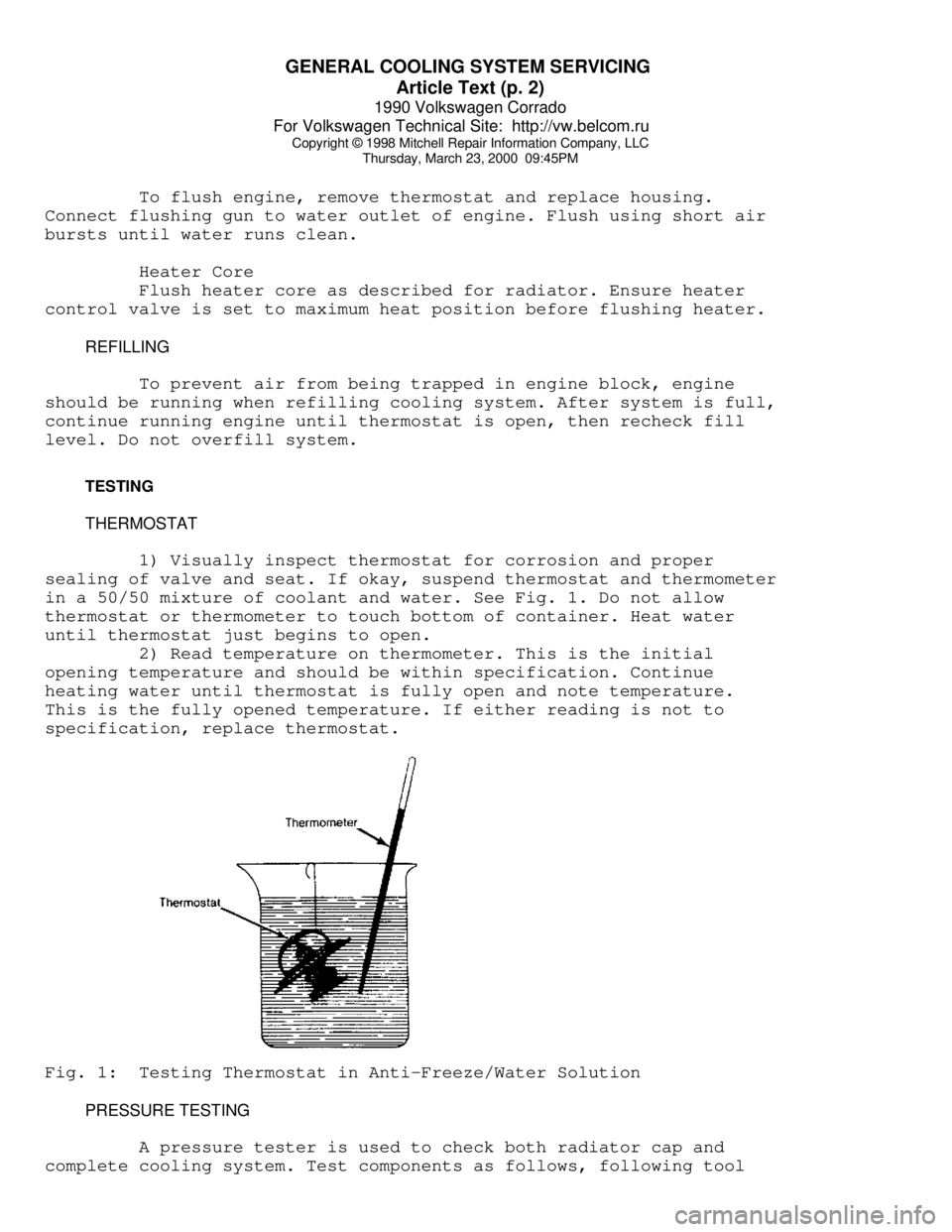1990 VOLKSWAGEN CORRADO coolant temperature
[x] Cancel search: coolant temperaturePage 572 of 906

GENERAL COOLING SYSTEM SERVICING
Article Text (p. 2)
1990 Volkswagen Corrado
For Volkswagen Technical Site: http://vw.belcom.ru
Copyright © 1998 Mitchell Repair Information Company, LLC
Thursday, March 23, 2000 09:45PM
To flush engine, remove thermostat and replace housing.
Connect flushing gun to water outlet of engine. Flush using short air
bursts until water runs clean.
Heater Core
Flush heater core as described for radiator. Ensure heater
control valve is set to maximum heat position before flushing heater.
REFILLING
To prevent air from being trapped in engine block, engine
should be running when refilling cooling system. After system is full,
continue running engine until thermostat is open, then recheck fill
level. Do not overfill system.
TESTING
THERMOSTAT
1) Visually inspect thermostat for corrosion and proper
sealing of valve and seat. If okay, suspend thermostat and thermometer
in a 50/50 mixture of coolant and water. See Fig. 1. Do not allow
thermostat or thermometer to touch bottom of container. Heat water
until thermostat just begins to open.
2) Read temperature on thermometer. This is the initial
opening temperature and should be within specification. Continue
heating water until thermostat is fully open and note temperature.
This is the fully opened temperature. If either reading is not to
specification, replace thermostat.Fig. 1: Testing Thermostat in Anti-Freeze/Water Solution
PRESSURE TESTING
A pressure tester is used to check both radiator cap and
complete cooling system. Test components as follows, following tool
Page 575 of 906

H - TESTS W/O CODES
Article Text (p. 2)
1990 Volkswagen Corrado
For Volkswagen Technical Site: http://vw.belcom.ru
Copyright © 1998 Mitchell Repair Information Company, LLC
Thursday, March 23, 2000 09:45PM
WILL NOT START OR STARTS HARD COLD (CRANKS OKAY)
* Check ignition fuse (if equipped).
* Check fuel pump fuse and fuel pump relay.
* Verify air intake system is unrestricted.
* Ensure fuel system pressure and volume are correct.
* Check cold start valve and thermo time switch operation.
* Ensure airflow sensor plate is in rest position. Adjust as
necessary.
* Test coolant temperature sensor and wiring. Repair or replace
as required.
* Check for poor ignition ground (1.8L & 2.0L 16-valve engines).
* Check for poor quality or contaminated fuel.
* Check condensation (water) in fuel tank causing fuel pump to
freeze (cold climate).
* Check exhaust system for restriction.
* Test airflow meter. Replace if faulty.
* Ensure sufficient secondary spark is available.
* Check air induction system for cracks or restriction.
* Ensure vacuum hoses are not disconnected or damaged.
* Ensure fuel system residual pressure is correct.
* Ensure fuel injector operation is correct.
* Ensure EGR valve operation is correct and valve closes
completely (if equipped).
* Check for cracks or poor connections at throttle body.
* Ensure ignition and valve timing are correct.
* Check ignition coil primary connections and wiring harness.
* Ensure ignition coil resistance is within specification.
* Check air temperature sensor operation (if equipped).
* Ensure electrical harness and connectors are not broken or loose.
* Ensure ECU or ignition control unit has correct voltage supply
and is properly grounded.
* Ensure engine has sufficient compression.
* Inspect intake air components for leaking hoses, connections or
cracks. Repair as required.
WILL NOT START OR STARTS HARD HOT (CRANKS OKAY)
* Check ignition fuse (if equipped).
* Check fuel system fuse and fuel pump relay.
* Check for poor quality or contaminated fuel.
* Check condensation (water) in fuel tank causing fuel pump to
freeze (cold climate).
* Check exhaust system for restriction.
* Check cold start valve and thermo time switch operation.
* Check fuel system and control system pressure. Replace pressure
regulator if necessary.
* Check residual fuel pressure. Replace fuel pump check valve or
fuel accumulator as necessary.
* Check oxygen sensor system operation.
* Ensure airflow sensor plate is in rest position. Adjust as
Page 576 of 906

H - TESTS W/O CODES
Article Text (p. 3)
1990 Volkswagen Corrado
For Volkswagen Technical Site: http://vw.belcom.ru
Copyright © 1998 Mitchell Repair Information Company, LLC
Thursday, March 23, 2000 09:45PM
necessary.
* Ensure injector spray patterns and volume are correct. Replace
faulty injectors.
* Inspect fuel lines and connections for leaks.
* Check carbon canister solenoid valves (CIS-E Motronic).
* Test airflow meter. Replace if faulty.
* Ensure sufficient secondary spark is available.
* Check air induction system for cracks or restriction.
* Check airflow sensor plate rest position.
* Ensure vacuum hoses are not disconnected or damaged.
* Ensure EGR valve operation is correct and valve closes
completely (if equipped).
* Check for cracks or poor connections at throttle body.
* Ensure ignition and valve timing are correct.
* Check ignition coil primary connections and wiring harness.
* Ensure ignition coil resistance is within specification.
* Check air temperature sensor operation.
* Check coolant temperature sensor operation.
* Ensure electrical harness and connectors are not broken or loose.
* Ensure ECU or ignition control unit has correct voltage supply
and is properly grounded.
* Ensure engine has sufficient compression.
ENGINE STALLS OR IDLES ROUGH
* Check fuel system and control system pressure. Replace pressure
regulator if necessary.
* Check cold start valve for leaking (engine warm).
* Ensure injector spray patterns and volume are correct. Replace
faulty injectors.
* Test coolant temperature sensor and wiring. Repair or replace
as required.
* Inspect intake air components for leaking hoses, connections or
cracks. Repair as required.
* Ensure airflow sensor plate movement and rest position. Adjust
as necessary.
* Test idle switch and idle air stabilizer valve.
* Perform system electrical checks.
* Check airflow meter. Replace if faulty.
* Ensure idle RPM is correct.
* Check auxiliary air by-pass regulator.
* Check fuel injector electrical connections.
* Use stethoscope to verify fuel injectors are operating.
* Ensure sufficient secondary spark is available in all cylinders.
* Verify vacuum hose routing is correct and there are no
vacuum leaks.
* Check idle stabilizer operation.
* Check for EGR system malfunction (if equipped).
* Check O2 sensor operation.
* Check for distortion or cracks in fuel injector(s) plastic
connecting flange(s).
* Check for use of poor quality fuel containing insufficient
Page 577 of 906

H - TESTS W/O CODES
Article Text (p. 4)
1990 Volkswagen Corrado
For Volkswagen Technical Site: http://vw.belcom.ru
Copyright © 1998 Mitchell Repair Information Company, LLC
Thursday, March 23, 2000 09:45PM
cleaning additives. Prolonged use of poor quality fuel can
cause injector clogging and carbon build-up on intake system.
ENGINE MISFIRES OR HESITATES
CIS-E & CIS-E MOTRONIC
* Ensure injector spray patterns and volume are correct. Replace
faulty injectors.
* Check fuel system and control system pressure. Replace pressure
regulator if necessary.
* Check Oxygen (O2) sensor system operation.
* Check fuel lines and connections for leaks.
* Test coolant temperature sensor and wiring. Repair or replace
as required.
* Check airflow meter and throttle switch. Replace if faulty.
* Ensure vacuum hoses are not disconnected or damaged.
* Ensure electrical harness connectors and wires are not
broken or loose.
* Check cold start valve for leaking (engine warm).
DIGIFANT II
* Check airflow sensor flap and sensor resistance. Replace
if faulty.
* Inspect intake air components for leaking hoses, connections
or cracks. Repair as required.
* Test intake air preheating system. Replace faulty components
as required.
* Check fuel system and control system pressure. Replace pressure
regulator if necessary.
* Ensure vacuum hoses are not disconnected or damaged.
* Ensure electrical harness connectors and wires are not
broken or loose.
* Check cold start valve for leaking (engine warm).
* Check coolant temperature sensor operation.
* Check Oxygen (O2) sensor voltage output.
EXCESSIVE FAST IDLE
* Inspect accelerator pedal and cable for worn parts or binding.
* Test idle switch (if equipped).
* Test auxiliary air regulator and replace if necessary
(if equipped).
* Inspect throttle valve and adjust or replace as required.
* Check carbon canister solenoid valves (CIS-E Motronic).
* Test idle boost valve system operation (1.8L 8-valve engine
only). Replace faulty parts as necessary.
* Test coolant temperature sensor and wiring (Digifant II). Repair
or replace as required.
* Check throttle cable adjustment.
* Verify vacuum hose routing is correct.
Page 578 of 906

H - TESTS W/O CODES
Article Text (p. 5)
1990 Volkswagen Corrado
For Volkswagen Technical Site: http://vw.belcom.ru
Copyright © 1998 Mitchell Repair Information Company, LLC
Thursday, March 23, 2000 09:45PM
* Ensure there are no vacuum leaks.
* Check idle stabilizer operation (if equipped).
* Ensure fuel system pressure and volume are correct.
* Check auxiliary air by-pass regulator.
* Check cold start valve for leaking (engine warm).
ENGINE HESITATES ON ACCELERATION
* Inspect intake air components for leaking hoses
* Check injector spray pattern. Check for faulty injectors.
* Check cold start valve for leaking (engine warm).
* Check airflow sensor plate movement. Replace fuel distributor
as necessary.
* Check airflow sensor plate position. Adjust as necessary.
* Check fuel system and control system pressure. Replace pressure
regulator if necessary.
* Test airflow sensor plate potentiometer. Adjust or replace
as necessary.
* Perform system electrical checks.
* Check idle mixture CO adjustment. Adjust as necessary.
ENGINE LACKS POWER
* Test coolant temperature sensor and wiring. Repair or
replace as required.
* Check fuel system and control system pressure. Replace pressure
regulator if necessary.
* Check throttle cable adjustment.
* Check throttle switch. Adjust or replace as necessary.
* Check airflow sensor screen for damage or incorrect installation
(if equipped).
* Check ignition timing and knock sensor control (if equipped).
Adjust as necessary.
* Check EGR system for correct operation (if equipped).
* Ensure base timing is correct and timing advance system
is functional.
* Check transmission for correct downshift (auto. trans.)
* Check fuel tank filler tube for tampering of restrictor. If
tampering has occurred, check catalytic converter for lead
contamination and exhaust system restriction.
* Check for use of poor quality fuel containing insufficient
cleaning additives. Prolonged use of poor quality fuel can
cause injector clogging and carbon build-up on intake system.
* Inspect intake air element, housing, and preheating system.
* Check airflow sensor plate movement. Replace if necessary.
POOR FUEL MILEAGE
* Ensure idle speed, base timing and timing advance are
set to specifications.
* Check cold start valve for leaking (engine warm).
Page 579 of 906

H - TESTS W/O CODES
Article Text (p. 6)
1990 Volkswagen Corrado
For Volkswagen Technical Site: http://vw.belcom.ru
Copyright © 1998 Mitchell Repair Information Company, LLC
Thursday, March 23, 2000 09:45PM
* Check fuel system and control system pressure. Replace
pressure regulator if necessary.
* Check thermo time switch operation.
* Check airflow sensor voltage output.
* Check air induction system for leaks.
* Check fuel injector operation.
* Check coolant temperature sensor operation.
* Check Oxygen (O2) sensor operation.
ENGINE DIESELING
CIS-E & CIS-E MOTRONIC
* Ensure ignition timing and timing advance are set to
specifications.
* Check for engine overheating.
* Check cold start valve for leaking (engine warm).
* Check for leaking injectors.
* Check airflow sensor plate/control plunger rest position.
Adjust as necessary.
* Check carbon canister solenoid valve.
* Verify no leaks in exhaust system.
FAILED EMISSIONS TEST
* Test lambda control system. Replace if faulty.
* Check air/fuel mixture. Adjust if necessary.
* Ensure air intake system is not restricted.
* Ensure engine is at normal operating temperature.
* Ensure fuel system pressure is correct.
* Check cold start valve for leaking (engine warm).
* Check thermo time switch operation.
* Verify base timing is correct.
* Check for correct PCV valve operation.
* Check crankcase for gasoline contamination.
* Check idle stabilizer operation.
* Check EGR system for correct operation (if equipped).
* Check vapor recovery system operation.
* Check operation of coolant temperature sensor.
* Check fuel tank filler tube for tampering of restrictor.
If tampering has occurred, check catalytic converter for
lead contamination and exhaust system restriction.
* Check for use of poor quality fuel containing insufficient
cleaning additives. Prolonged use of poor quality fuel can
cause injector clogging and carbon build-up on intake system.
INTERMITTENT PROBLEM DIAGNOSIS
Intermittent fault testing requires duplicating circuit or
component failure to identify the problem. If necessary, monitor
voltage or resistance values using a DVOM while attempting to
Page 584 of 906

HEATER SYSTEM
Article Text (p. 4)
1990 Volkswagen Corrado
For Volkswagen Technical Site: http://vw.belcom.ru
Copyright © 1998 Mitchell Repair Information Company, LLC
Thursday, March 23, 2000 09:45PMFig. 3: Exploded View of Heater System (Vanagon)
Courtesy of Volkswagen United States, Inc.
HEATER ASSEMBLY R & I
REMOVAL (CABRIOLET & FOX)
1) Drain coolant from radiator. Loosen clamps and remove
heater core hoses. Disconnect battery ground cable. Pull heater
control knobs off. Remove trim plate and underdash access panels.
2) Disconnect wiring from blower motor, and remove cable from
temperature control lever. Pry spring clamp off with screwdriver and
separate heater assembly halves. Remove heater core and blower motor.
INSTALLATION
To install, insert blower motor and heater core into right
half of housing. Position left half and install spring clips. To
complete installation, reverse removal procedure.
REMOVAL (GOLF GL, GTI, JETTA & JETTA GLI)
1) Disconnect negative battery cable. Drain coolant from
radiator. Remove steering wheel. Remove lower left instrument panel
Page 585 of 906

HEATER SYSTEM
Article Text (p. 5)
1990 Volkswagen Corrado
For Volkswagen Technical Site: http://vw.belcom.ru
Copyright © 1998 Mitchell Repair Information Company, LLC
Thursday, March 23, 2000 09:45PM
retaining screws. Remove lower left instrument panel. Remove lower
right instrument panel tray retaining screws.
2) Remove lower right instrument panel. Remove gearshift
lever knob. Remove gearshift lever boot. Remove center console
retaining screws. Slide center console rearward. Disconnect electrical
connectors attached to center console. Remove center console.
3) Remove temperature control knobs. Remove trim plate.
Remove radio. Remove switches from instrument panel. Remove instrument
panel trim plate retaining screws. Remove instrument panel trim plate.
Remove instrument cluster retaining screws. Remove instrument cluster.
4) Disconnect speedometer cable, electrical connectors and
vacuum hoses from instrument cluster. Remove speaker grilles. Remove
air outlet grilles from housings. Remove housing retaining screws.
Remove air outlet housings. Remove instrument panel mounting nuts and
screws.
5) Remove instrument panel. Disconnect heater hoses from
heater core. Remove heater assembly mounting bolts and nuts. Remove
all attaching ducts. Disconnect cables from heater assembly. Remove
heater assembly.
INSTALLATION
Reverse removal procedure for installation. Fill radiator
with coolant and start engine. Ensure heater control is in warm
position to purge air from heater core.
WIRING DIAGRAMSFig. 4: Heater System Wiring Diagram (Cabriolet)Fig. 5: Heater System Wiring Diagram (Corrado)